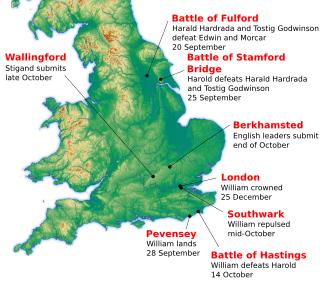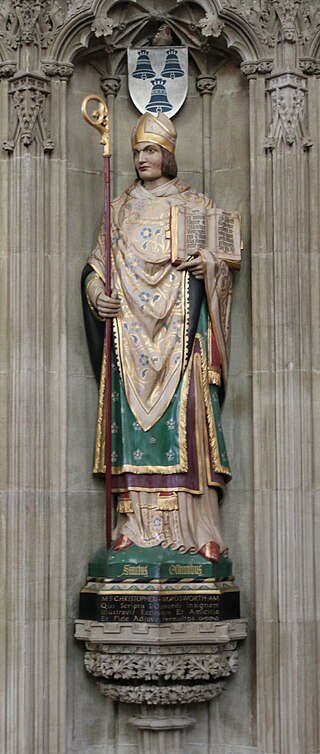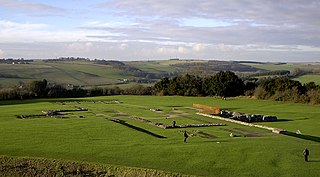Contents
| Other decades |
| 1050s | 1060s | 1070s | 1080s | 1090s |
Events from the 1070s in England .
| Other decades |
| 1050s | 1060s | 1070s | 1080s | 1090s |
Events from the 1070s in England .
The 1070s was a decade of the Julian Calendar which began on January 1, 1070, and ended on December 31, 1079.
Year 1070 (MLXX) was a common year starting on Friday of the Julian calendar, the 1070th year of the Common Era (CE) and Anno Domini (AD) designations, the 70th year of the 2nd millennium, the 70th year of the 11th century, and the 1st year of the 1070s decade.

The Norman Conquest was the 11th-century invasion and occupation of England by an army made up of thousands of Norman, French, Flemish, and Breton troops, all led by the Duke of Normandy, later styled William the Conqueror.

Stigand was an Anglo-Saxon churchman in pre-Norman Conquest England who became Archbishop of Canterbury. His birth date is unknown, but by 1020 he was serving as a royal chaplain and advisor. He was named Bishop of Elmham in 1043, and was later Bishop of Winchester and Archbishop of Canterbury. Stigand was an advisor to several members of the Anglo-Saxon and Norman English royal dynasties, serving six successive kings. Excommunicated by several popes for his pluralism in holding the two sees, or bishoprics, of Winchester and Canterbury concurrently, he was finally deposed in 1070, and his estates and personal wealth were confiscated by William the Conqueror. Stigand was imprisoned at Winchester, where he died.

Osmund, Count of Sées, was a Norman noble and clergyman. Following the Norman conquest of England, he served as Lord Chancellor and as the second bishop of Salisbury, or Old Sarum.
The Revolt of the Earls in 1075 was a rebellion of three earls against William I of England. It was the last serious act of resistance against William in the Norman Conquest.
Stigand was the last Bishop of Selsey, and first Bishop of Chichester.

The Accord of Winchester is the 11th-century document that establishes the primacy of the archbishop of Canterbury over the archbishop of York.

Remigius de Fécamp was a Benedictine monk who was a supporter of William the Conqueror.

Walkelin was the first Norman Bishop of Winchester. He began the construction of Winchester Cathedral in 1079 and had the Old Minster demolished. He reformed the cathedral's administration, although his plan to replace the monks with priests was blocked by the Archbishop of Canterbury, Lanfranc. Walkelin was important in beginning St Giles's Fair in Winchester and was greatly active in national politics. For example, he signed the Accord of Winchester, was involved in the Council of London in 1075, and sought to resolve a conflict between Anselm of Canterbury and William II. He was regent of England for a few months at the end of his life.
Events from the 1100s in England.
Events from the 1090s in England.
Events from the 1080s in England.
Events from the 1060s in England.
Events from the 1050s in England.
The Council of London in 1075 was a council of the Catholic Church in England held by the new Norman archbishop of Canterbury Lanfranc five years after his installation. Other attendees included Gisa, Bishop of Wells and William the Norman. The Council of London produced several decrees, these were known as the "Canons of the Council of London AD 1075".

Salisbury Cathedral School is a co-educational private school in Salisbury, Wiltshire, England, which was founded in 1091 by Saint Osmund. The choristers of Salisbury Cathedral are educated at the school.

Old Sarum Cathedral was a Catholic and Norman cathedral at old Salisbury, now known as Old Sarum, between 1092 and 1220. Only its foundations remain, in the north-west quadrant of the circular outer bailey of the site, about 2 miles (3.2 km) north of the centre of modern Salisbury, Wiltshire, in the United Kingdom. The cathedral was the seat of the bishops of Salisbury during the early Norman period and the original source of the Sarum Rite.